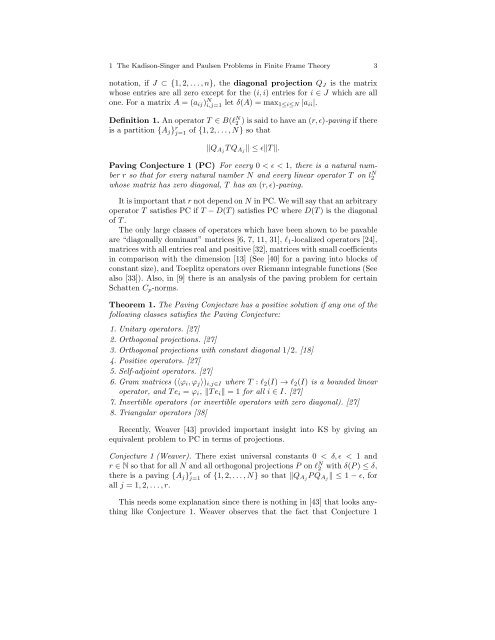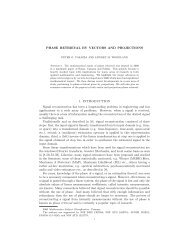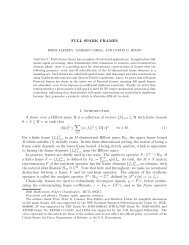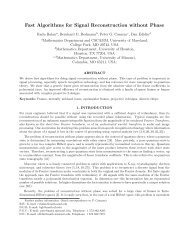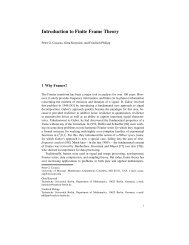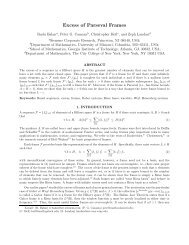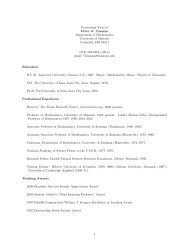The Kadison-Singer and Paulsen Problems in Finite Frame Theory
The Kadison-Singer and Paulsen Problems in Finite Frame Theory
The Kadison-Singer and Paulsen Problems in Finite Frame Theory
You also want an ePaper? Increase the reach of your titles
YUMPU automatically turns print PDFs into web optimized ePapers that Google loves.
1 <strong>The</strong> <strong>Kadison</strong>-<strong>S<strong>in</strong>ger</strong> <strong>and</strong> <strong>Paulsen</strong> <strong>Problems</strong> <strong>in</strong> F<strong>in</strong>ite <strong>Frame</strong> <strong>The</strong>ory 3notation, if J ⊂ {1, 2, . . . , n}, the diagonal projection Q J is the matrixwhose entries are all zero except for the (i, i) entries for i ∈ J which are allone. For a matrix A = (a ij ) N i,j=1 let δ(A) = max 1≤i≤N |a ii |.Def<strong>in</strong>ition 1. An operator T ∈ B(l N 2 ) is said to have an (r, ɛ)-pav<strong>in</strong>g if thereis a partition {A j } r j=1 of {1, 2, . . . , N} so that‖Q Aj T Q Aj ‖ ≤ ɛ‖T ‖.Pav<strong>in</strong>g Conjecture 1 (PC) For every 0 < ɛ < 1, there is a natural numberr so that for every natural number N <strong>and</strong> every l<strong>in</strong>ear operator T on l N 2whose matrix has zero diagonal, T has an (r, ɛ)-pav<strong>in</strong>g.It is important that r not depend on N <strong>in</strong> PC. We will say that an arbitraryoperator T satisfies PC if T − D(T ) satisfies PC where D(T ) is the diagonalof T .<strong>The</strong> only large classes of operators which have been shown to be pavableare “diagonally dom<strong>in</strong>ant” matrices [6, 7, 11, 31], l 1 -localized operators [24],matrices with all entries real <strong>and</strong> positive [32], matrices with small coefficients<strong>in</strong> comparison with the dimension [13] (See [40] for a pav<strong>in</strong>g <strong>in</strong>to blocks ofconstant size), <strong>and</strong> Toeplitz operators over Riemann <strong>in</strong>tegrable functions (Seealso [33]). Also, <strong>in</strong> [9] there is an analysis of the pav<strong>in</strong>g problem for certa<strong>in</strong>Schatten C p -norms.<strong>The</strong>orem 1. <strong>The</strong> Pav<strong>in</strong>g Conjecture has a positive solution if any one of thefollow<strong>in</strong>g classes satisfies the Pav<strong>in</strong>g Conjecture:1. Unitary operators. [27]2. Orthogonal projections. [27]3. Orthogonal projections with constant diagonal 1/2. [18]4. Positive operators. [27]5. Self-adjo<strong>in</strong>t operators. [27]6. Gram matrices (〈ϕ i , ϕ j 〉) i,j∈I where T : l 2 (I) → l 2 (I) is a bounded l<strong>in</strong>earoperator, <strong>and</strong> T e i = ϕ i , ‖T e i ‖ = 1 for all i ∈ I. [27]7. Invertible operators (or <strong>in</strong>vertible operators with zero diagonal). [27]8. Triangular operators [38]Recently, Weaver [43] provided important <strong>in</strong>sight <strong>in</strong>to KS by giv<strong>in</strong>g anequivalent problem to PC <strong>in</strong> terms of projections.Conjecture 1 (Weaver). <strong>The</strong>re exist universal constants 0 < δ, ɛ < 1 <strong>and</strong>r ∈ N so that for all N <strong>and</strong> all orthogonal projections P on l N 2 with δ(P ) ≤ δ,there is a pav<strong>in</strong>g {A j } r j=1 of {1, 2, . . . , N} so that ‖Q A jP Q Aj ‖ ≤ 1 − ɛ, forall j = 1, 2, . . . , r.This needs some explanation s<strong>in</strong>ce there is noth<strong>in</strong>g <strong>in</strong> [43] that looks anyth<strong>in</strong>glike Conjecture 1. Weaver observes that the fact that Conjecture 1


